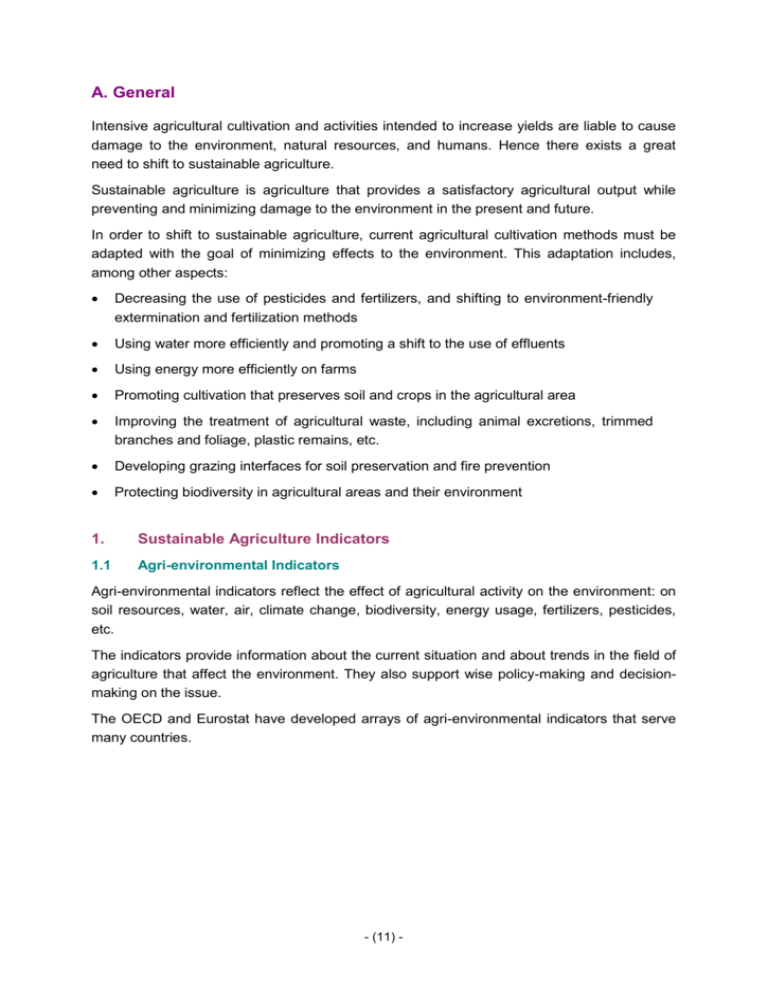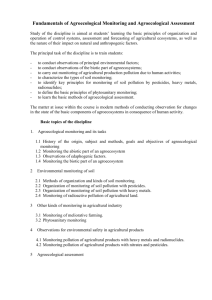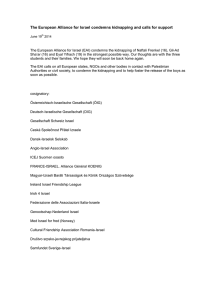soil emissions
advertisement

A. General Intensive agricultural cultivation and activities intended to increase yields are liable to cause damage to the environment, natural resources, and humans. Hence there exists a great need to shift to sustainable agriculture. Sustainable agriculture is agriculture that provides a satisfactory agricultural output while preventing and minimizing damage to the environment in the present and future. In order to shift to sustainable agriculture, current agricultural cultivation methods must be adapted with the goal of minimizing effects to the environment. This adaptation includes, among other aspects: Decreasing the use of pesticides and fertilizers, and shifting to environment-friendly extermination and fertilization methods Using water more efficiently and promoting a shift to the use of effluents Using energy more efficiently on farms Promoting cultivation that preserves soil and crops in the agricultural area Improving the treatment of agricultural waste, including animal excretions, trimmed branches and foliage, plastic remains, etc. Developing grazing interfaces for soil preservation and fire prevention Protecting biodiversity in agricultural areas and their environment 1. Sustainable Agriculture Indicators 1.1 Agri-environmental Indicators Agri-environmental indicators reflect the effect of agricultural activity on the environment: on soil resources, water, air, climate change, biodiversity, energy usage, fertilizers, pesticides, etc. The indicators provide information about the current situation and about trends in the field of agriculture that affect the environment. They also support wise policy-making and decisionmaking on the issue. The OECD and Eurostat have developed arrays of agri-environmental indicators that serve many countries. - (11) - 1.2 Agri-environmental Indicators in Israel In connection with its joining the OECD, Israel studied the indicators customarily used by this organization and in the European Union to describe the effect of agriculture on the environment. Based on these indicators and on the needs of decision-makers on the local level, a joint staff from the Ministry of Agriculture and the ICBS classified the indicators according to their level of availability in the bureaus. This publication presents the group of indicators that involved the data available at this stage. Due to the data’s limited level of detail, the indicators presented in this publication are at the national level, not the individual farm level. Agri-environmental indicators presented in the publication: Nutrient balance in agriculture indicator (the elements N-P-K) – the difference between total entry (input) of nutrients into the soil and the quantity of nutrients that leave the soil (output) Ammonia emissions indicator – emissions of ammonia from the agricultural sector as part of total emissions in Israel Greenhouse gas emissions from agriculture indicator – emissions of greenhouse gases from the agricultural sector as part of total emissions in Israel Water usage in agriculture indicator – the use of water in agriculture, by type of water Pesticides in Israel indicator – sales of pesticides (active ingredients), according to the various intended uses. Indicators to be developed in the future: Land uses and crop areas Potential of soil erosion by water and wind Salinization of soil Biodiversity in agriculture Energy use in agriculture - (12) - B. Main Findings Agriculture in Israel is defined as intensive agriculture, in which the aim is to maximize the output per unit of input. The goal is to obtain a large quantity of good-quality produce while best utilizing the limited resources available. Agriculture makes use of various inputs, including fertilizers, soil improvers such as manure compost, sludge from waste treatment plants, fresh water, effluents, pesticides, and energy. The wide usage of these inputs has a substantial effect on the environment. Approximately 70,000 tons of synthetic fertilizer per year was imported into Israel during 2000–2006. Starting in 2007, imports decreased due to an increase in prices, finally falling to 54,000 tons per year. These fertilizers, which are added to the field, have an effect on the balance of elements in the soil, on the natural water quality, as well as on greenhouse gas emissions. Agriculture makes use of large quantities of sludge, which forms in the wastewater treatment plants and in the manure of various animals. Starting in 2000, there was a steady increase in the quantities of effluents and sludge directed to agriculture. These products have an effect on the balance of elements in the soil, on emissions of ammonia and greenhouse gases to the air, as well as on the natural water quality. Relative to the amounts of agricultural area and plant produce in Israel, usage of pesticides is higher than in other countries. Pesticides are liable to harm the natural water, biodiversity, and under certain conditions, even humans. 1. Nutrient balance in agriculture 1.1 Nitrogen balance in the soil During the years surveyed, the nitrogen balance in the soil ranged between 39,118–66,223 tons per year. The quantity of nitrogen that entered the soil was substantially greater than the quantity removed from it. Therefore, the nitrogen balance was affected mostly by the changes in nitrogen entering the soil. The majority of removal of nitrogen from the soil occurs due to the removal of produce and due to consumption of the agricultural crops. The minority occurs due to consumption of plants by animals in pasture areas. Calculation of the nitrogen balance per agricultural area forms a basis for comparisons over years and among different regions. The changes in the nitrogen balance were parallel to the changes in the nitrogen balance per agricultural area because the agricultural area changed only slightly. During 2005–2008, the average nitrogen balance of kg. per hectare in Israel was higher than that of most European Union countries included in the publication, and lower than the average in the Netherlands. - (13) - In addition, a comparison of the average nitrogen balances in the European Union countries for 2005–2008 showed that the balance in most of the countries decreased compared to the previous years. However, in Israel, Poland, and the Czech Republic, the balance increased. 1.2 Phosphorus balance in the soil During the years surveyed, the phosphorus balance in the soil ranged between 13,995– 18,774 tons per year. Similar to nitrogen, the quantity of phosphorus that entered the soil was substantially greater than the quantity removed from it. Therefore, the phosphorus balance was affected mostly by the changes in phosphorus entering the soil. Calculation of the phosphorus balance per agricultural area forms a basis for comparisons over years and among different regions. The changes in the phosphorus balance were parallel to the changes in the phosphorus balance per agricultural area because the agricultural area changed only slightly. During 2005–2008, the average phosphorus balance of kg. per hectare in Israel was the highest of selected European Union countries. In addition, a comparison of the average phosphorus balances in the European Union countries for 2005–2008 showed that the balance in Luxembourg, Germany, and France decreased compared to the previous years. However, in Israel, Hungary, Norway, and Poland, the balance increased. 2. Ammonia emissions from agriculture In Israel in 2012, ammonia emissions from the agricultural sector totalled 15,922 tons. Ammonia emissions increased over the period 2000–2012, corresponding to an increase in the number of animals on farms in Israel. Israel’s ammonia emissions from agriculture per capita were among the lowest among other OECD countries. 3. Greenhouse Gas Emissions From Agriculture Greenhouse gas emissions in Israel in 2011 totalled approximately 78.5 million tons. Of these, 2.6 million tons (3.3%) were from agriculture. The share of agriculture out of all greenhouse gas emissions decreased between 1996 and 2003, from 4.3% to 3.2%, respectively. Since then and up to 2011, the share remained similar. International comparison shows that the ratio of greenhouse gas emissions from agriculture per dunam in Israel is not among the highest. In Israel, the ratio is 0.8 tons per dunam of agricultural land. - (14) - 4. Water Usage in Agriculture Data from 1996–2011 on water usage in agriculture by type of water show a substantial decrease in consumption of fresh water in agriculture (from 892 million cubic meters in 1996 to 414 million cubic meters in 2011). The decrease in consumption of fresh water for irrigation occurred along with the substantial increase in irrigation with non-fresh water (from 392 million cubic meters in 1996 to 628 million cubic meters in 2011). Despite the increase in use of effluents in agriculture and the reduction in use of fresh water, the net agricultural product did not decrease and in fact it increased over the years due to increased efficiency in agriculture. However, the long-term implications of use of effluents on agricultural soil and the environment are not yet clear. In Israel, water consumption in agriculture during 2000–2008 decreased by approximately 1.5%. Comparisons with other OECD countries show that in Denmark, this percentage increased by 30%. In contrast, in France and Slovakia, consumption decreased markedly (by 47% and 81%, respectively). 5. Pesticides in Israel In 2008–2010, between 6.6 and 7.3 thousand tons of active ingredients from pesticide formulations were sold in Israel. The main usages over the years have been fungicides and bactericides, fumigants, herbicides, insecticides and acaricides. Sales of the active ingredients in the formulations for these usages constituted over 90% of the total sales during the surveyed years. In 2009, sales of active ingredients decreased by approximately 9%, whereas in 2010 there was an increase of approximately 2%. The increases and decreases in the amounts of active ingredients sold might have occurred due to changes in the prices of pesticides, changes in the mix of crops, changes in the pesticides that are approved and recommended for use, changes in growing conditions, and changes in stock. In Israel in 2010, the ratio of tons of active ingredients to thousand dunams of agricultural land area (vegetables, and field crops) was approximately 3.2 tons of active ingredients per thousand dunams of agricultural land area. This ratio was considerably higher than the ratios in other selected countries. - (15) -






